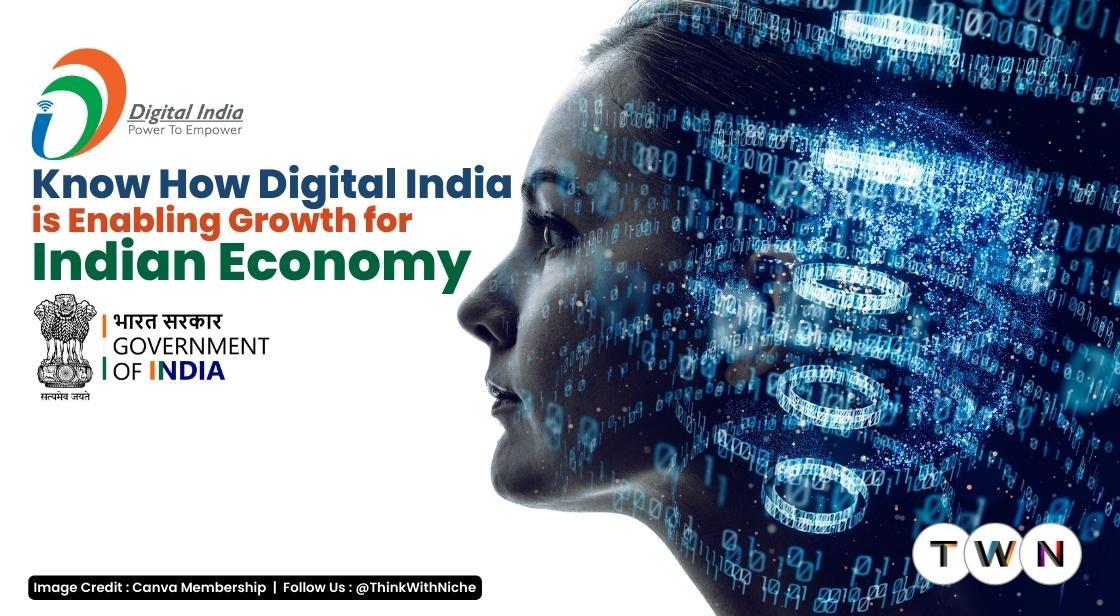Know How Digital India Is Enabling Growth For Indian Economy

Blog Post
India wants to become a $1 trillion economy By 2025, the digital economy will be more visible because of the pandemic condition that is currently affecting the ecosystem and its effects. The demand curve will change as a result of investments in digital technology, and enterprises will grow tremendously.
The infrastructure, the way business is done, and the method for selling goods online make up the three primary components of the digital economy.
Consumer behavior has changed as a result of digitization, which has also created potential to serve underserved or unserved markets, increase supply chain efficiency, create economies of scale, and reduce prices.
All of this has been made possible by the improvements made over the last ten years, including the expansion of digital infrastructure, a sharp decline in data prices, and a surge in the use of smartphones.
India is predicted to have 900 million active internet users by 2025, with a penetration rate of 45% as of January 2021. Only behind China and the US, India has the third-largest online consumer base (140 million). According to a 2021 Bain-Flipkart analysis, the e-retail sector is predicted to reach $120-140 billion by FY26, growing at a rate of about 25–30 percent annually over the following five years.
In the light of above facts, it is important to Know How Digital India Is Enabling Growth For the Indian Economy.
As the world recovers from the Covid-19 pandemic, India has become a bright spot on the economic horizon. During the present and the following few years, India will continue to be the largest economy with the quickest rate of growth.
The GDP is anticipated to expand by 7% in FY23 whereas the World Bank's most recent prediction for FY24 is 6.6%. In contrast, only 1.7% growth in the global economy is predicted for 2023.
For the first time in many years, India would be the world's largest economy, despite the fact that most of the other major economies are experiencing a considerable slowdown in economic growth.
The fast-expanding digital economy in India is one of the main forces influencing this economic revolution.
Know How Digital India Is Enabling Growth For Indian Economy
The Digital India program has substantially benefited the digital economy, which is anticipated to grow from its current level of around $300 billion to $1 trillion by FY27, boosting its proportion in the GDP from about 9% to about 20% over this time.
As a result, the digital economy would play a significant role in our country's total economic growth. How did the country's broader economy come to rely so heavily on the digital economy?
Aim To Digitize All Services
Across the board, digitalization is spurring innovation and releasing significant gains in productivity and efficiency in the public and private sectors.
Aadhaar for digital identity, Unified Payments Interface (UPI) for online payments, Government e-Marketplace (GeM) for public procurement, Goods and Services Tax Network (GSTN) for indirect taxation and GatiShakti for logistics are just a few of the major national public digital platforms that the government has developed that have completely changed how businesses and government agencies conduct business.
These platforms have made it possible for the government to completely digitize all services aimed at citizens and businesses, as well as enabling enterprises to digitalize their operations and receive payments and tax refunds immediately.
Through consent-based online data exchange, fully online Account Aggregators are now readily providing credit to people and MSMEs without any paperwork. These are significantly enhancing the flow of credit and maximizing the use of resources throughout the entire economy.
The government has heavily digitized practically every aspect of governance, which has improved both the ease of doing business and the quality of life for citizens.
In order to digitalize their services, the majority of government agencies at the central, state, and local levels have engaged in extensive process re-engineering. This has helped to make the entire approval process and service delivery time-bound and predictable. Despite the majority of the legislation governing these sectors remaining the same, this has been accomplished.
What is the primary force behind India's digital transformation?
India has a young population, with 840 million or so internet users, and smartphone adoption is increasing quickly, even in rural areas. More and more individuals are going online thanks to the availability of fast 4G networks and the most affordable data rates in the world. During the epidemic, digital tools were increasingly used for both personal and professional purposes.
The rapidly growing 5G network and increasing optical fiber penetration in BharatNet-assisted villages will help in soon connecting the last 40% of our population to the internet.
Startups may now build innovative enterprises and compete globally due to the economy's massive digitalization.
Today, roughly 80,000 startups with a combined capitalization of about $450 billion are overwhelmingly tech-focused. The Indian startup ecosystem is the third largest in the world, with over 100 unicorns.
Emerging technologies like artificial intelligence, blockchain, augmented and virtual reality, the Internet of Things, metaverse, Industry 4.0, etc. are predicted to accelerate the contribution of the digital economy to India's economic growth.
These are, however, also anticipated to present new difficulties, particularly in addressing online user harms, cybersecurity, and privacy and personal data protection.
India would need to concentrate on developing a world-class digital infrastructure, including new-age data centers, becoming a global hub for electronics and semiconductor manufacturing, creating world-leading public digital platforms in domains like healthcare, agriculture, education, logistics, etc., ensuring cybersecurity, driving innovation through the emerging technologies, bringing new legal and regulatory frameworks, and more in order to enable the digital economy to drive the next phase of growth in the broader economy.
Within this decade, India will become the world leader in the digital economy if this vision for the next phase of Digital India is realized.
Also Read: How To Use DigiLocker As A Digital Governance Tool
India's digital revolution
India's government launched the Digital India program in July 2015 with the goal of transforming the country into a knowledge-based economy with strong digital capabilities. This was the beginning of the country's digital revolution. The purpose of the Digital India program, according to Prime Minister Mr. Narendra Modi, is to enhance the lives of common people. It sought to provide the populace of the nation with "accessible, affordable, and useful" technology. The initiative was broken down into several components: governance, on-demand services, digital citizen empowerment, and digital infrastructure as a utility for all citizens. After six years of work, the nation has strengthened its digital infrastructure and increased internet access across the board. As new digital applications permeate and transform a variety of activities and types of work on a national scale, India is set for the next phase of growth, the production of enormous economic value and the empowerment of millions of Indians.
India's digital revolution benefits
The digital revolution in India has greatly helped the nation. The government has used its digital environment to better the lives of its residents during the past six years. Through Direct Benefit Transfer (DBT) initiatives, India has transferred a total of Rs. 22 lakh crore (US$ 300 billion) through the JAM ecosystem. The method of electronic payments has also been revolutionized by the government. With 48 billion transactions in 2021, India will have the most real-time transactions globally. This is 6.5 times larger than the combined populations of the US, Canada, France, and Germany, and it is approximately three times larger than China, which has 18 billion people. The measures taken by the Indian government go beyond transaction standardization. Through the GST, the government was able to integrate more than 63 million MSMEs into the formal economy in 2019. As a result of this formalization, businesses are now required to use technology for tax filing and other purposes, which is assisting India's expanding internet adoption.
Indian government's most recent digital revolution initiatives
With its "Digital India" initiative to advance e-governance, give people access to government entities, build out digital infrastructure nationwide, and connect Indians' internet, the government of India has been at the forefront of digitization since 2015. Since then, India has completed a number of initiatives to strengthen its digital ecosystem. The government has promised additional reforms, including plans to increase semiconductor manufacturing, electronic manufacturing, and drone manufacturing, in order to maintain the momentum of India's digital revolution. Several important changes that will accelerate India's digital transformation include:
Open Network for Digital Commerce (ONDC)
The Open Network for Digital Commerce (ONDC) in India is referred to as the country's equivalent of the Unified Payments Interface (UPI). The government insists that the Open Network for Digital Commerce (ONDC) will digitize the entire value chain, standardize operations, encourage supplier participation, boost logistical effectiveness, and raise customer value. In India's digital economy, this network will offer open networks for all facets of exchanging products and services. 17 banks and financial institutions have contributed a total of Rs. 157.5 crore (US$ 20.30 million) to the ONDC platform for the project's first phase.
Aim to provide high-quality internet
To deliver accessible and high-quality Internet, the Indian government has made a number of initiatives. The BharatNet Fiber project and investments in the creation of 5G and 6G infrastructure are among these investments. The 5G ecosystem in India is anticipated to contribute US$ 450 billion to the Indian economy over the next 15 years, according to a statement from Mr. Piyush Goyal, the Union Minister of Commerce and Industry, Consumer Affairs, Food and Public Distribution, and Textiles.
Reforms in India's Digital Payments
The 5G ecosystem in India is anticipated to contribute US$ 450 billion to the Indian economy over the next 15 years, according to a statement from Mr. Piyush Goyal, the Union Minister of Commerce and Industry, Consumer Affairs, Food and Public Distribution, and Textiles.
India's digital payment ecosystem would be significantly improved, according to the Indian government. In order to serve rural India, the government has pushed for UPI to be made available on feature phones. UPI has been developed to a worldwide level by NPCI International Payments Ltd (NIPL), with countries including the UAE and Nepal actively engaging in the UPI ecosystem. India's digital transformation will be accelerated and would benefit the entire world. A Digital Rupee has also been proposed by the government, according to the Union Budget for 2022–2023,
Push for Data Centers
The Indian government has announced intentions to encourage investments in the construction of data centers in order to promote India's digital transformation. By 2024, the nation's data center capacity will have grown by 34%, to 1.3 GW. By 2024, Mumbai and Chennai are anticipated to have 68% of the nation's capacity.
Conclusion
The digital revolution in India will result in a paradigm shift for the country and its economy. India may become the country with the fastest-growing digital economy with the aid of public and private partnerships, favorable government policies, creative reforms, a demographic advantage, rising incomes, and the expansion of the startup culture in India. The digital revolution in India is predicted to present a $1 trillion potential. The Indian economy has already benefited from the digital revolution by being more adaptable to the times. Future projections indicate that India's digital economy will help the country reach its target of a $5 trillion GDP.
You May Like
EDITOR’S CHOICE












